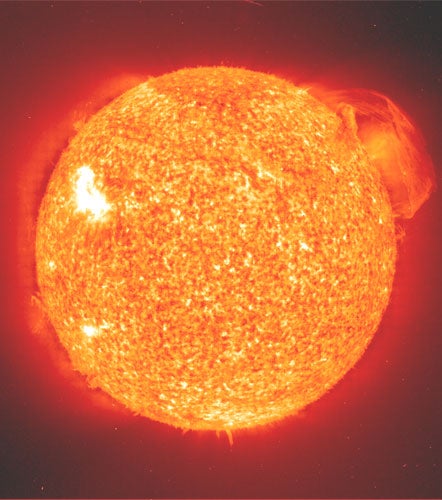Do not adjust your sets: solar storms could cause blackouts at Olympics

With terrorist threats, dire transport links and overspent budgets you'd be forgiven for thinking that the 2012 London Olympics had enough problems to worry about. But another nightmare scenario has just been added to the Olympic dream – a communications blackout caused by solar storms.
After a period of unprecedented calm within the massive nuclear furnace that powers the Sun, scientists have detected the signs of a fresh cycle of sunspots that could peak in 2012, just in time for the arrival of the Olympic torch in London.
Over the past two years, fewer sunspots have been recorded than at any time since 1913. But now scientists have detected signs that the next cycle has begun and it could peak in two or three years.
They believe that this peak in the next solar cycle could generate the eruption of vast solar explosions that could fling billions of tonnes of charged particles towards the Earth, causing intense solar storms that could jam the telecommunications satellites and internet links transmitting live Olympic coverage from London.
"The Sun is now waking up. The first significant active regions of a new solar activity cycle are forming. In the last two weeks, we have seen the first major flares of a new cycle," said Professor Richard Harrison, head of space physics at the Rutherford Appleton Laboratory in Oxfordshire.
"The Sun's activity has a strong influence on the Earth. Space weather can affect the whole population. The recipe is right, it's the beginning of a new cycle. The Olympics could be bang in the middle of the next solar maximum which could affect the transmissions of satellites," he added.
Sunspots are the physical manifestation of the Sun's natural fluctuations in magnetic activity which operate on a roughly 11-year cycle. At the peak of the cycle, violent eruptions called coronal mass ejections occur in the Sun's atmosphere, flinging out immense quantities of electrically-charged matter.
"A coronal mass ejection can carry a billion tonnes of solar material into space at over a million kilometres per hour. Such events can expose astronauts to deadly particle doses, can disable satellites, cause grid failures on Earth and disrupt communications," Professor Harrison said.
In 1989, a solar storm caused power blackouts across the US and Canada. Orbiting satellites are especially vulnerable to the effects of solar flares erupting from the Sun's surface, and the risk is greatest during a solar maximum when there is the greatest number of sunspots.
Next week, the US National Aeronautics and Space Administration (Nasa) is scheduled to launch a satellite for monitoring solar activity called the Solar Dynamics Observatory, which will take images of the Sun that are 10 times better than high-definition television.
The Rutherford Appleton Laboratory, funded by the Science and Technology Facilities Council, helped to make the sophisticated cameras that will capture images of the solar flares and explosions as they occur.
Professor Richard Holdaway, the lab's director of space science, said that the observatory should be able to provide early warning of a solar flare or eruption big enough to affect satellite communications on Earth.
"If we have advance warning, we'll be able to mitigate the damage. What you don't want is things switching off for a week with no idea of what's caused the problem," Professor Holdaway said.
It is not possible to predict exactly when the peak in solar activity will occur or how intense it is likely to be. The most intense solar maximum in recent years occurred in 1958, when the Northern Lights were sighted as far south at Mexico on three separate occasions. But even a below-average peak in solar activity can still cause problems. The great geomagnetic storm of 1859, which set fire to telegraph offices in the United States, occurred during a cycle with a lower-than-normal number of sunspots.
Join our commenting forum
Join thought-provoking conversations, follow other Independent readers and see their replies
Comments
Bookmark popover
Removed from bookmarks